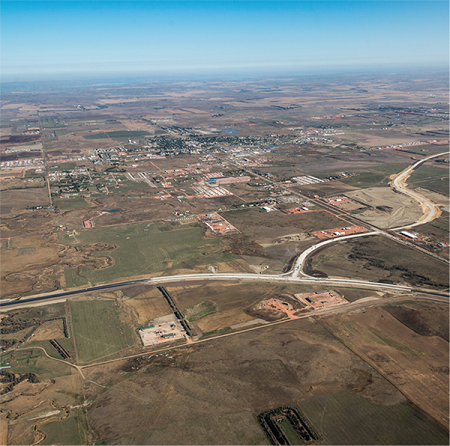
Context Sensitive Solutions and Design:
A Practical Approach to Transportation Decisionmaking
The Context Sensitive Solutions and Design process (CSS/D) is a combined, interdisciplinary decisionmaking process and design approach to transportation projects that equally values the needs of government agencies and communities, while considering all trade-offs involved in planning, project development, and design. This process involves thinking beyond traditional transportation objectives to consider goals such as stewardship, livability, active transportation, and placemaking. The CSS/D process allows for greater participation of stakeholders, elected officials, interest groups, and affected local, State, and Federal agencies by involving them in the decisionmaking process. The overall CSS/D process is guided by four core principles:
- A shared stakeholder vision to provide a basis for decisions;
- A comprehensive understanding of contexts, including the physical, economic, and social setting;
- Continual communication and collaboration to achieve consensus; and
- Design flexibility and creativity to shape effective transportation solutions, while preserving and enhancing community and natural environments.
This issue of Successes in Stewardship focuses on technical assistance on CSS/D provided by the Federal Highway Administration (FHWA) to State Departments of Transportation (DOTs) and highlights the Watford City bypass project in North Dakota as an example of the benefits of integrating CSS/D principles into the transportation planning and project delivery process. FHWA provides technical assistance on CSS/D implementation for the purpose of assisting State DOTs to better integrate these principles into their decisionmaking processes. This assistance focuses on context sensitive design and flexibility, resilient transportation planning, accelerating project delivery in rural areas, and incorporating CSS/D into project development, planning, and Complete Streets. Most recently, FHWA provided targeted CSS/D assistance in six States: Delaware, Florida, Idaho, Minnesota, North Dakota, and Washington. Summary reports of the assistance provided in these States are available on FHWA’s CSS/D website as well as additional information and resources related to the CSS/D process.
Watford City, ND Puts CSS Principles into Context with Bypass Project

Traffic headed east through Watford City, prior to the bypass (image courtesy of FHWA).
In the late 2000s, western North Dakota experienced a boom in oil production, leading to an expansion in employment, population, and traffic. On U.S. Highway 85 in Watford City, daily vehicle traffic increased 375 percent between 2006 and 2012. The traffic caused significant amounts of bottlenecking and automobile crashes, making it extremely difficult and unsafe to travel in and out of the city. With a growing population, Watford City also experienced a housing shortage, which resulted in a lack of proper accommodation for the surrounding population.
North Dakota DOT’s (NDDOT) solution to the capacity challenges and increased travel times was to construct a bypass around Watford City so vehicles could avoid passing through downtown. In following the aforementioned CSS/D principles 1 and 2, NDDOT responded to concerns from local businesses and sponsored an origin-destination study that affirmed the bypass would not be a detriment to local businesses. By addressing these concerns, NDDOT demonstrated a commitment to achieving a shared stakeholder vision as a basis for developing the solution.
Given the regional significance of the route and the large volume of heavy truck traffic, NDDOT decided on a four-lane facility, which met their roadway design manual standards to offer high levels of mobility and reliability in order to support economic activity. To minimize the project footprint, NDDOT decided to use a flush median, which is painted on the road surface and requires less space than other median types such as grass. Choosing the flush median also allowed NDDOT to remain flexible to future development in the area by not having to install median crossings. Rumble strips were later placed in the medians to increase safety. The design considerations selected for the bypass showcase a true understanding of the context and NDDOT’s flexibility in developing an effective transportation solution. By selecting a four-lane facility with a flush median, NDDOT accommodated the truck traffic along the route while reducing impact to the surrounding communities and natural environment.
The public involvement process for the bypass project started very early, to secure buy-in from community stakeholders and allow them to help determine project alternatives. Proactive and early personal engagement with local landowners, Tribes, and other stakeholders allowed NDDOT to identify potential challenges and strategize how to resolve them. Input from Watford City officials, along with public feedback, ultimately lead to the selection of the preferred alternative which fully avoided the cultural resources identified through comprehensive engagement with Tribes through a tribal consultation committee and cultural resource inventories. NDDOT’s engagement with local stakeholders throughout the bypass project showcases the third CSS/D core principle and demonstrates how DOTs can work to achieve buy-in early and ensure that local stakeholders feel a sense of ownership and understand the value of the project. NDDOT’s deliberate public engagement illustrates that effective transportation solutions can be implemented while preserving valued aspects of the community environment.
CSS/D Accelerates Watford City Bypass Project Schedule, Minimizes Environmental Impact, and Supports NDDOT’s Transportation Decisionmaking

Overhead view of the Watford City Bypass (image courtesy of FHWA).
By using the CSS/D approach and core principles, NDDOT was able to successfully accelerate project schedules and improve environmental outcomes of the Watford City bypass. In accordance with principles 1 and 3, NDDOT facilitated collaboration around a shared vision with resource agencies through monthly Interagency Coordination Meetings, which created trust between project stakeholders and a collective understanding of project concerns, particularly with regards to the National Environmental Policy Act (NEPA) process. This protocol kept partner agencies informed about the current status of the project and created opportunities to discuss minimizing and avoiding environmental impacts and to resolve any issues that arose during construction.
In addition to the systems in place to facilitate collaboration with other agencies, NDDOT employed other practices that served to expedite the decisionmaking and project delivery processes. For instance, NDDOT funded two full-time positions—one at the U.S. Army Corps of Engineers and another at the U.S. Fish and Wildlife Service—to help accelerate the environmental review process and ensure timely decisions for the bypass project. NDDOT also employed a unique management strategy in which a single project manager oversaw the project, rather than multiple project managers from each NDDOT division. This allowed for concurrent reviews and proved to be effective in streamlining communications and accelerating the project timeline.
Bypass Project Highlights Replicable CSS/D Practices Other States Can Implement
A region’s transportation system has a large impact on all aspects of quality of life, including economic health, safety, housing, land use, mobility, and public health. Construction of the Watford City bypass was completed in fall 2014 and has been a crucial improvement to the transportation system. The project highlights how a CSS/D based approach contributed to improved quality of life for Watford City residents. NDDOT utilized several CSS/D practices, such as close collaboration with environmental resource agencies, flexibility in design, and proactive public engagement, to deliver a successful transportation project while optimizing agency resources. Other DOTs can replicate and adopt similar practices to take advantage of the benefits of CSS/D, including accelerated project development and delivery, increased community buy-in, and improved quality of life.
Contact Information
Fleming El-Amin
FHWA Office of Human Environment
(202) 366-0233
Fleming.El-Amin@dot.gov
Carolyn Nelson, P.E.
FHWA Office of Project Development and Environmental Review
(502) 223-6765
Carolyn.Nelson@dot.gov
Look What’s New!
- The Advisory Council on Historic Preservation (ACHP) issued a Program Comment to exempt consideration of effects to rail properties within rail rights-of-way.
- Need a tool to help facilitate electronic review of your environmental documents and improve interagency collaboration? Try FHWA’s electronic collaboration tool eNEPA.
- Nominations for the 2019 Environmental Excellence Awards are open and will be accepted until September 28, 2018. The awards recognize outstanding transportation projects, processes, and organizations that incorporate environmental stewardship into the planning and project development processes using FHWA funding sources. For additional information, visit this page.
Successes in Stewardship is a Federal Highway Administration newsletter highlighting current environmental streamlining and stewardship practices from around the country. Click here to subscribe, or call (617) 494-2013 for more information.

